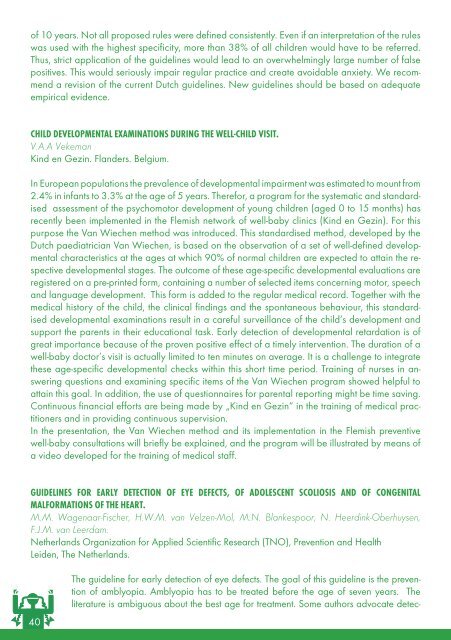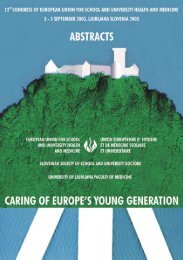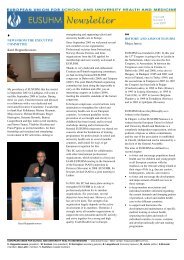abstract ok.indd - eusuhm
abstract ok.indd - eusuhm
abstract ok.indd - eusuhm
Create successful ePaper yourself
Turn your PDF publications into a flip-book with our unique Google optimized e-Paper software.
of 10 years. Not all proposed rules were defined consistently. Even if an interpretation of the rules<br />
was used with the highest specificity, more than 38% of all children would have to be referred.<br />
Thus, strict application of the guidelines would lead to an overwhelmingly large number of false<br />
positives. This would seriously impair regular practice and create avoidable anxiety. We recommend<br />
a revision of the current Dutch guidelines. New guidelines should be based on adequate<br />
empirical evidence.<br />
CHILD DEVELOPMENTAL EXAMINATIONS DURING THE WELL-CHILD VISIT.<br />
V.A.A Vekeman<br />
Kind en Gezin. Flanders. Belgium.<br />
In European populations the prevalence of developmental impairment was estimated to mount from<br />
2.4% in infants to 3.3% at the age of 5 years. Therefor, a program for the systematic and standardised<br />
assessment of the psychomotor development of young children (aged 0 to 15 months) has<br />
recently been implemented in the Flemish network of well-baby clinics (Kind en Gezin). For this<br />
purpose the Van Wiechen method was introduced. This standardised method, developed by the<br />
Dutch paediatrician Van Wiechen, is based on the observation of a set of well-defined developmental<br />
characteristics at the ages at which 90% of normal children are expected to attain the respective<br />
developmental stages. The outcome of these age-specific developmental evaluations are<br />
registered on a pre-printed form, containing a number of selected items concerning motor, speech<br />
and language development. This form is added to the regular medical record. Together with the<br />
medical history of the child, the clinical findings and the spontaneous behaviour, this standardised<br />
developmental examinations result in a careful surveillance of the child’s development and<br />
support the parents in their educational task. Early detection of developmental retardation is of<br />
great importance because of the proven positive effect of a timely intervention. The duration of a<br />
well-baby doctor’s visit is actually limited to ten minutes on average. It is a challenge to integrate<br />
these age-specific developmental checks within this short time period. Training of nurses in answering<br />
questions and examining specific items of the Van Wiechen program showed helpful to<br />
attain this goal. In addition, the use of questionnaires for parental reporting might be time saving.<br />
Continuous financial efforts are being made by „Kind en Gezin“ in the training of medical practitioners<br />
and in providing continuous supervision.<br />
In the presentation, the Van Wiechen method and its implementation in the Flemish preventive<br />
well-baby consultations will briefly be explained, and the program will be illustrated by means of<br />
a video developed for the training of medical staff.<br />
GUIDELINES FOR EARLY DETECTION OF EYE DEFECTS, OF ADOLESCENT SCOLIOSIS AND OF CONGENITAL<br />
MALFORMATIONS OF THE HEART.<br />
M.M. Wagenaar-Fischer, H.W.M. van Velzen-Mol, M.N. Blankespoor, N. Heerdink-Oberhuysen,<br />
F.J.M. van Leerdam.<br />
Netherlands Organization for Applied Scientific Research (TNO), Prevention and Health<br />
Leiden, The Netherlands.<br />
40<br />
The guideline for early detection of eye defects. The goal of this guideline is the prevention<br />
of amblyopia. Amblyopia has to be treated before the age of seven years. The<br />
literature is ambiguous about the best age for treatment. Some authors advocate detec-




